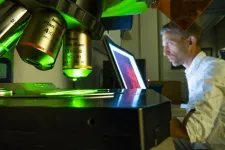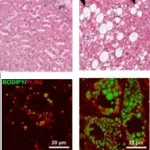(Press-News.org) Special immune cells found in the brain, microglia, play a key role in the processes that make you feel uneasy and depressed in correlation with inflammation. This is the conclusion of a study using mice carried out by researchers at Linköping University, Sweden. The results have been published in the scientific journal Immunity, and suggest that microglial cells contribute to the negative mood experienced during several neurological diseases, and maybe also depression.
David Engblom's research group at Linköping University has spent many years looking at why inflammation in the body, such as a common cold or influenza, causes us to feel poorly and despondent, and why we feel like retiring into our shell. The activity of the immune system influences nerve cells in some way. However, normal cells of the immune system are not able to get into the brain: it is sensitive and must be protected. Instead, the brain has its own special immune cells: microglial cells.
Previous research has shown that microglial cells are activated in several neurological diseases, such as Alzheimer's disease, Parkinson's disease and stroke. People who are affected by these conditions also often fall into a negative mood. Other previous research has suggested that inflammatory processes also play a role in the development of depression. This led the researchers behind the new study to examine more closely whether microglial cells are involved in regulating mood during inflammation.
"The study showed that animals feel sick and uneasy when we activate the microglial cells. We demonstrate that two signal molecules, interleukin-6 and prostaglandin E2, are particularly important in these processes. It's not surprising that these signal substances are central, but we were a bit surprised that it is the microglial cells that release these molecules", says David Engblom, professor in the Department of Biomedical and Clinical Sciences (BKV) at Linköping University.
During inflammation, many processes are initiated in several cell types. One of the challenges in determining the role played by a specific cell type in the body, therefore, is to isolate its effects. In this study, the scientists used a technique known as chemogenetics, which enabled them to switch on the activity specifically in microglial cells in mice. The researchers activated the microglial cells when the mice were being kept in a certain type of surroundings. The mice subsequently avoided this type of surroundings, which the researchers interpret as showing that the animals disliked the experience. The mice also became less interested in a sweet solution, which they normally find very tempting.
In order to investigate whether the microglial cells are an important link between the immune system and mood, the researchers investigated what happened when microglial cells are inhibited. When the microglial cells were not available for activation, the mice did not feel poorly, even when they had inflammation. This reinforces the idea that these cells are necessary for the process.
"Our results show that the activation of microglial cells is sufficient to create aversion and negative mood in mice. It's natural to suggest that similar processes take place in several human diseases. It's not unlikely that activated microglia contribute to the discomfort and depressed mood in people with inflammatory and neurological diseases", says David Engblom.
If further research demonstrates that the biological mechanism described in the study functions in the same way in humans, it may be possible in the long run to reduce symptoms of depression by inhibiting this mechanism.
INFORMATION:
The study has been financed with support from, among others, the Swedish Research Council, the Knut and Alice Wallenberg Foundation, the Swedish Brain Foundation, Stiftelsen för Parkinsonforskning i Linköping, the Lars Hierta Memorial Foundation, and Region Östergötland.
The article: "Microglial activation elicits a negative affective state through prostaglandin-mediated modulation of striatal neurons", Anna M. Klawonn, Michael Fritz, Silvia Castany, Marco Pignatelli, Carla Canal, Fredrik Similä, Hugo A. Tejeda, Julia Levinsson, Maarit Jaarola, Johan Jakobsson, Juan Hidalgo, Markus Heilig, Antonello Bonci and David Engblom, Immunity, published online on 20 January 2021, doi: 10.1016/j.immuni.2020.12.016
https://www.cell.com/immunity/fulltext/S1074-7613(20)30544-6
Artificial intelligence and automation are changing the world, one industry at a time! Whatever humans can do, machines are learning to also do effectively, with lower costs and fewer errors. The maritime shipping industry is no different. Ships are now increasingly automated (called maritime autonomous surface ships or MASSs), reducing the need for human input. While this bodes well for labor and fuel costs, the question naturally raised is, what happens to the jobs of seafarers, the chief workforce of the shipping industry, once MASSs take over.
To find out, researchers from Korea used complex mathematical models and simulations ...
RESEARCH TRIANGLE PARK, N.C. -- Design of Army aerial vehicles and weapon systems relies on the ability to predict aerodynamic behavior, often aided by advanced computer simulations of the flow of air over the body. High-fidelity simulations assist engineers in maximizing how much load a rotorcraft can lift or how far a missile can fly, but these simulations aren't cheap.
The simulations that designers currently use require extensive data processing on supercomputers and capture only a portion of vortex collision events - which can cause significant performance degradation, from loss of lift on a rotor to complete loss of control of a munition. A new turbulence model could change that.
The Army Research Office, an ...
Teenagers with happy childhood memories are likely to drink less, take fewer drugs and enjoy learning, according to research published in the peer-reviewed journal END ...
New Orleans, LA - An analysis by Nicholas Gilpin, PhD, Professor of Physiology and Associate Director of the Alcohol and Drug Abuse Center of Excellence at LSU Health New Orleans School of Medicine, and Michael Taffe, PhD, Professor of Psychiatry at the University of California San Diego, summarizes long-standing racial inequities in federal funding for biosciences research from the National Institutes of Health (NIH). Their report describes prior failures to correct these racial inequities and offers strategies that may be effective in eliminating these disparities. Their paper, published online in the open-access ...
Nonalcoholic fatty liver disease (NAFLD) is a widespread condition in the Western World. Around 30% of the population have lipid droplets stored in their liver which diminish its function in the long term. Main causes for NAFLD are our high-caloric diet in combination with a sedentary lifestyle. Hitherto, researchers have not fully understood the cause of this disease and despite the high number of affected individuals, there is no approved therapy.
In order to improve our understanding of the basic mechanisms underlying the etiology of NAFLD, Dr. Nina Graffmann, Prof. James Adjaye and the team of the Institute for Stem Cell research and Regenerative Medicine from the University Hospital Duesseldorf differentiated induced pluripotent stem cells (iPSCs) derived from healthy ...
Using a combination of telescopes, including the Very Large Telescope of the European Southern Observatory (ESO's VLT), astronomers have revealed a system consisting of six exoplanets, five of which are locked in a rare rhythm around their central star. The researchers believe the system could provide important clues about how planets, including those in the Solar System, form and evolve.
The first time the team observed TOI-178, a star some 200 light-years away in the constellation of Sculptor, they thought they had spotted two planets going around it in the same orbit. However, a closer look revealed something entirely ...
CHICAGO (January 25, 2021; 9 am CST): A new study finds that older cancer patients are less likely to have optimal results following their cancer operation if they live in an area highly affected by social challenges, especially if they are racial-ethnic minorities. The study was selected for the 2020 Southern Surgical Association Program and published as an "article in press" on the Journal of the American College of Surgeons website in advance of print.
Study investigators from The Ohio State University (OSU) used a novel risk stratification tool called the social vulnerability index (SVI), a composite measure of 15 social and economic factors. ...
The key factor in preventing non-communicable diseases is lifestyle management at the individual level with a focus on such innovations, which can help increase the awareness of risk factors management in society, claim an international team of researchers, among them - scientists from Kaunas University of Technology (KTU), Lithuania in a recent study. According to them, the management of cancer, diabetes, cardiovascular and respiratory diseases requires many strategies from several perspectives and on different levels.
Non-communicable diseases (NCDs), also known as chronic diseases, are medical conditions that are ...
What happened to the promised applications of graphene and related materials? Thanks to initiatives like the European Union's Graphene Flagship and heavy investments by leading industries, graphene manufacturing is mature enough to produce prototypes and some real-life niche applications. Now, researchers at Graphene Flagship partner The Fraunhofer Institute for Systems and Innovation Research (ISI) in Karlsruhe, Germany, have published two papers that roadmap the expected future mass introduction of graphene and related materials in the market.
Back in 2004, graphene was made by peeling off atomically thin layers from a graphite block. Now, thanks to the advances pioneered by the Graphene Flagship, among ...
A team from the Computer Vision Center (CVC) and the University of Barcelona has published the results of a study that evaluates the accuracy and bias in gender and skin colour of automatic face recognition algorithms tested with real world data. Although the top solutions exceed the 99.9% of accuracy, researchers have detected some groups that show higher false positive or false negative rates.
Face recognition has been routinely used by both private and governmental organizations worldwide. Automatic face recognition can be used for legitimate and beneficial purposes (e.g. to improve security) but at the same time its power and ubiquity increases a potential negative ...





